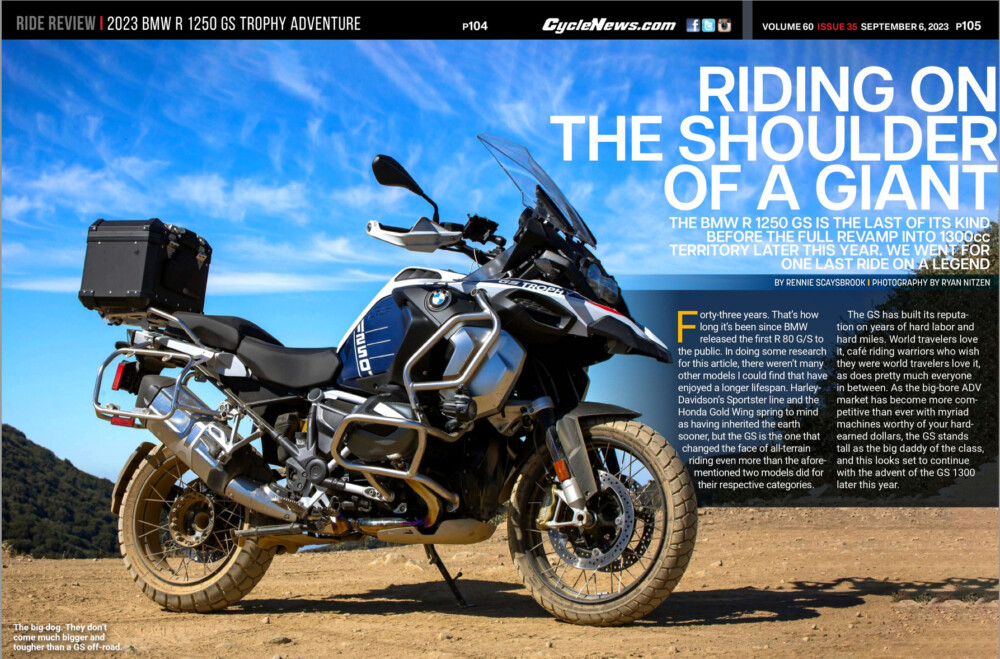Rennie Scaysbrook | September 7, 2023
The BMW R 1250 GS is the last of its kind before the full revamp into 1300cc territory later this year. We went for one last ride on a legend.
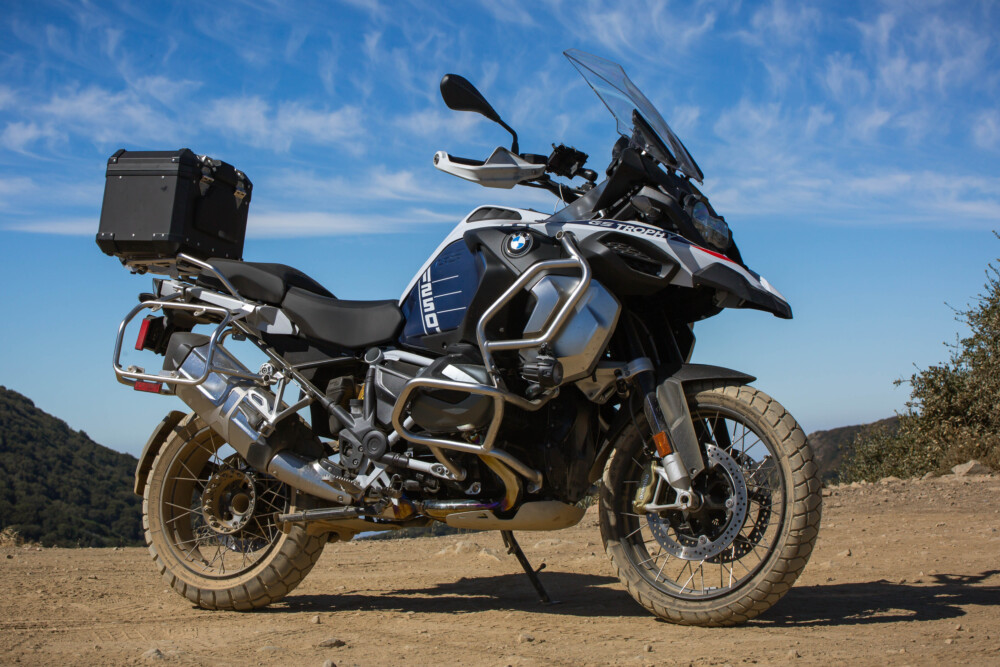 The big dog. They don’t come much bigger and tougher than a GS off-road.
The big dog. They don’t come much bigger and tougher than a GS off-road.
Photography by Ryan Nitzen
Forty-three years. That’s how long it’s been since BMW released the first R 80 G/S to the public. In doing some research for this article, there weren’t many other models I could find that have enjoyed a longer lifespan. Harley-Davidson’s Sportster line and the Honda Gold Wing spring to mind as having inherited the earth sooner, but the GS is the one that changed the face of all-terrain riding even more than the aforementioned two models did for their respective categories.
The GS has built its reputation on years of hard graft and hard miles. World travelers love it, café riding warriors who wish they were world travelers love it, and as does pretty much everyone in between. As the big-bore ADV market has become more competitive than ever with myriad machines worthy of your hard-earned dollars, the GS stands tall as the big daddy of the class, and this looks set to continue with the advent of the GS 1300 later this year.
Until then, however, BMW gave me the proximity key to their premium 2022 offering, the last to bear the 1250 badge—the $24,685 GS Trophy Adventure. Now, there’s not a massive difference between this and the base model GS Adventure save for the fancy paint and a few ergo changes, but that’s fine with me. The Trophy pays homage to the firm’s GS Trophy rally, the now legendary (among BMW riders) test of man and machine that pits teams from countries across the globe against each other in a series of tests using GS 1250s.
The 2024 GS Trophy launch will be held in Namibia, Africa, and while it’s almost unattainable for most riders to gain a spot on the U.S. team for the event, you can at least rep the colors with this GS Trophy Adventure.
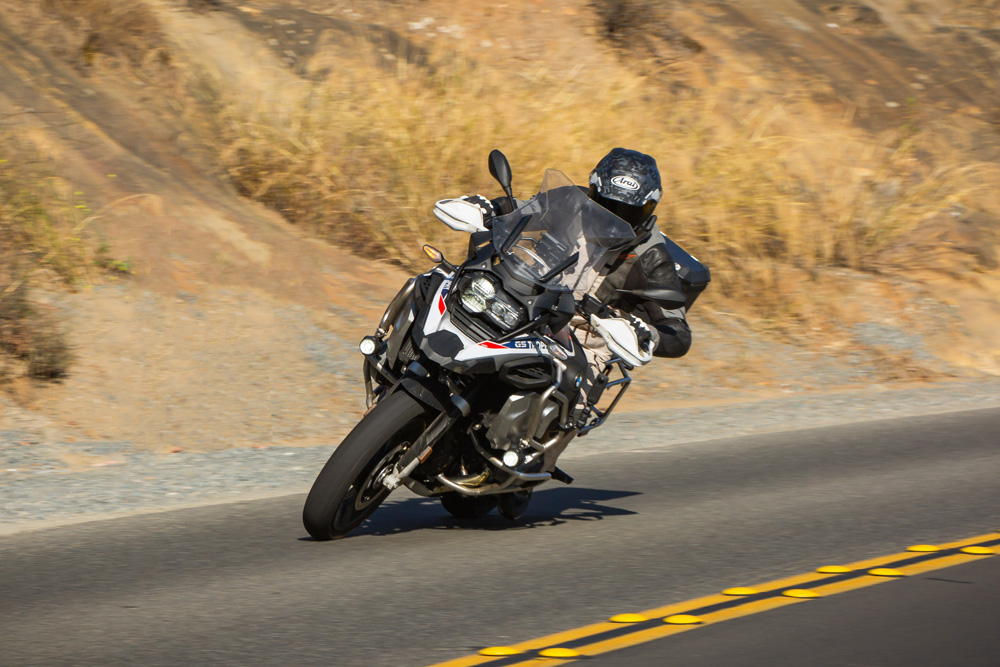 On-road performance is incredible for such a versatile machine.
On-road performance is incredible for such a versatile machine.
Back to the bike.
The 1254cc flat-twin powering the Trophy Adventure is the same as you’ll get in the base GS and GS Adventure, with a claimed 136 horsepower at 7750 rpm and 105 lb-ft of torque claimed at 6250 rpm. Compared to the arm-stretching KTM 1290 Super Adventure R, which rolls to the grid with a claimed 160 horsepower and 102 lb-ft, some might scoff at what the BMW brings to the table, but the odds of you actually maxing out 160 horsepower on a bike dedicated to mainly off-road riding is close to zero.
The Trophy Adventure enjoys a beautiful spread of power, but it’s not an engine that likes to be ridden into the reds. That flat drone that comes from the single exhaust gives an inkling into how it wants to be ridden, that being to click up to top gear on the Gear Shift Assist Pro (quickshifter) and let the torque do the talking.
Low- to mid-rpm performance is particularly impressive, especially in Enduro mode, as the throttle hit is nowhere near as abrupt as that in the road-oriented Dynamic mode. The dreaded jacking of the shaft drive that has been an unwanted BMW trademark is still apparent but nowhere near as evident as it once was. Pick a dirt road, any road, and the GS happily cruised along as the Telelever front suspension and single-sided swingarm Paralever rear soaked up damn near anything I was willing to throw at it.
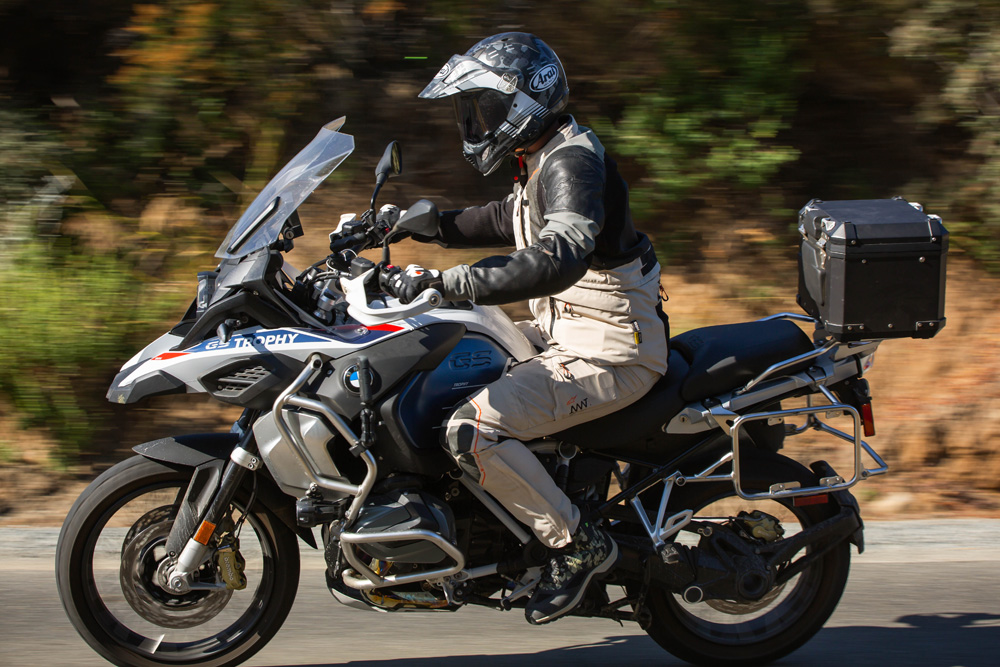 The 35-inch seat height and 1.2-inch higher set handlebars make the GS Trophy a near-perfect fit for the taller riders out there.
The 35-inch seat height and 1.2-inch higher set handlebars make the GS Trophy a near-perfect fit for the taller riders out there.
The suspension is of course electronically adjustable via the Dynamic ESA with the rider, rider with luggage, two riders, and two riders with luggage. These can be changed further with the simple Soft/Normal or Hard settings within Dynamic ESA itself.
You’re dealing with a large motorcycle here. With a claimed weight of 591 pounds with a full 7.9 gallons of gas, this is by far one of the heaviest ADVs on the market. That gas load is situated high up, and you need to be wary of weight transfer when fully fueled on dirt roads. However, the ergonomics with the 30mm higher handlebar risers give the rider a sure-footed feeling, allowing taller riders plenty of comfort and ease of maneuverability.
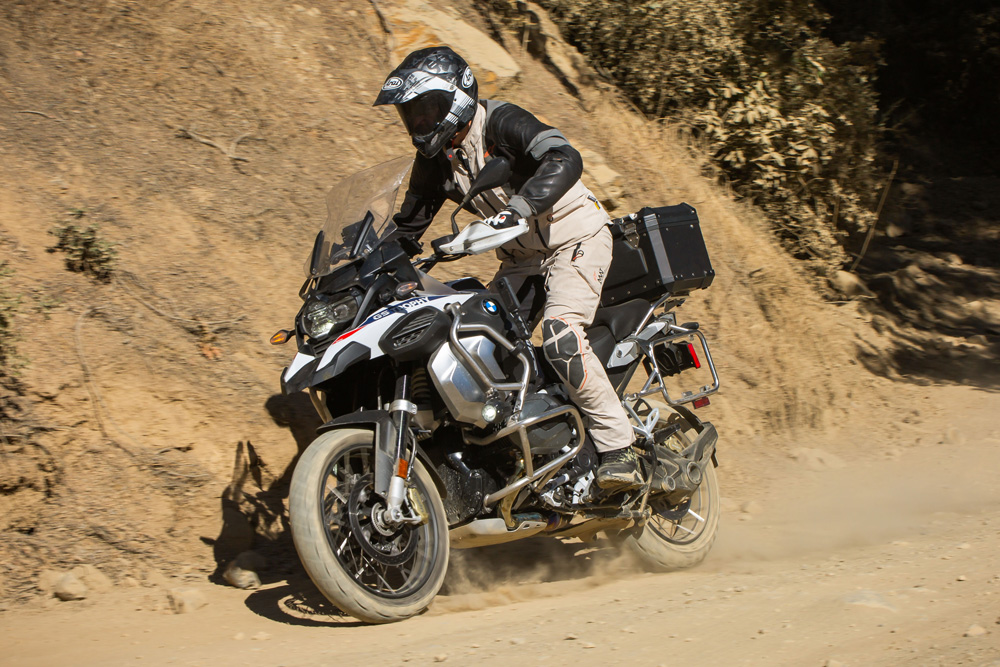 Fully fueled, you need to be wary of the Trophy’s weight. Regardless, off-road is where the machine really shines.
Fully fueled, you need to be wary of the Trophy’s weight. Regardless, off-road is where the machine really shines.
The sheer size of the GS Trophy Adventure will be one of the drawbacks for shorter riders. The seat height is a tall 35 inches, which suits me fine at my 6’1” height. Conversely, the scale of the motorcycle makes it a near-perfect companion for long touring days in the saddle, which a recent two-day trip to Laguna Seca from Orange County via the long way confirmed.
However, the seat can get pretty hard after 45 minutes on board. It’s comfortable until that time, but there’s almost a tipping point when it goes from comfy to damn near unbearable—at least for me—and despite the fact it comes with seat heating as standard, I’d be looking at a custom seat if big mile days were in my GS’s future.
Compared to the early days of the GS story, the 2023 edition is a rolling computer. However, BMW’s been at the electronics game longer than anyone else, and the ride suite is one of the more intuitive out there. Four ECU modes of Rain, Road, Dynamic and Enduro are all you’ll need, and the adjustment within the systems themselves will have you occupied for longer than you’d like (unless you’re into that sort of thing).
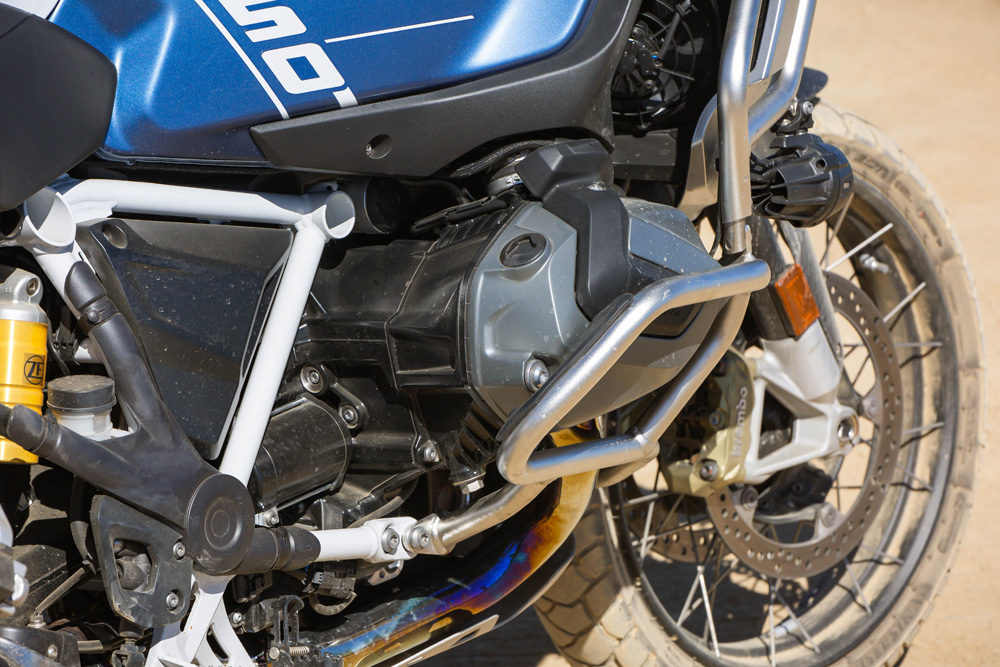 BMW’s 1250 ShiftCam motor is a gem of a thing. It’ll be interesting to see how much more power BMW squeezes out of it in 1300cc guise.
BMW’s 1250 ShiftCam motor is a gem of a thing. It’ll be interesting to see how much more power BMW squeezes out of it in 1300cc guise.
Dynamic Traction Control is a given that changes its intervention with the ECU modes selected, but the Trophy also comes with three ride modes of Eco, Rain and Road, which can be independently variable within the four ECU modes. There’s also Hill Hold Assist as standard, so you don’t need to hold the front or rear brakes while on a hill waiting for the traffic lights to change.
Speaking of lights, the Trophy comes with LED Cornering lights and when combined with the fog lights, it means you’ll light up the road at night better than most cars. You can also change the electronics so the indicators have a slightly dimmed permanent light to them, which will increase your visibility to oncoming traffic.
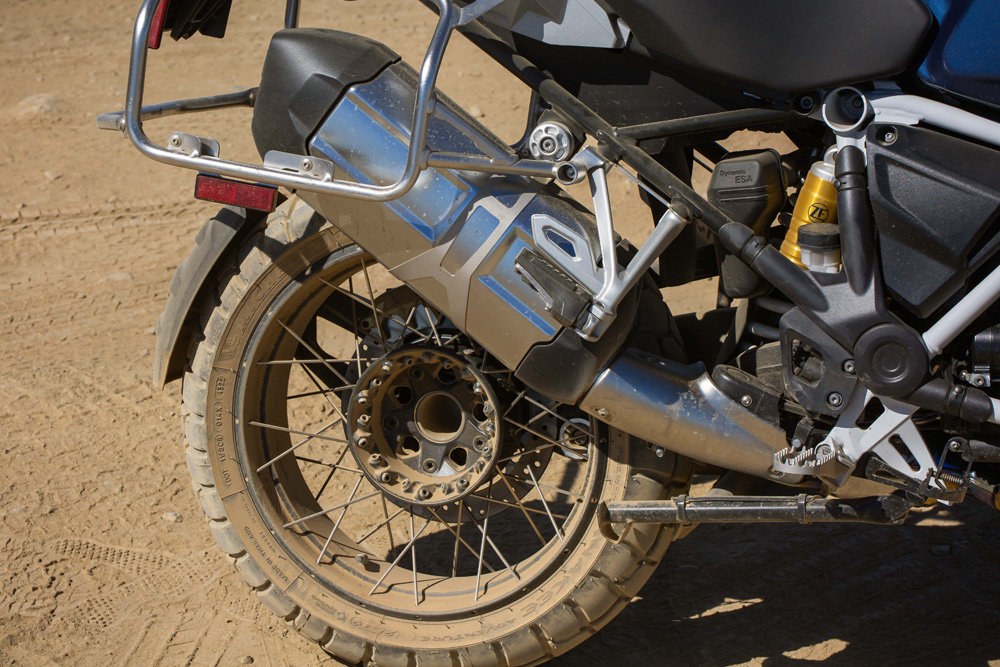 Single-sided swingarm and Paralever rear suspension give a very confident ride over rough terrain.
Single-sided swingarm and Paralever rear suspension give a very confident ride over rough terrain.
At the end of the day, I could throw all kinds of specs at you, but after my two weeks on board the Trophy, I came to the same conclusion that I had when I rode the first water-cooled GS back in 2013, that being, if I had to buy one bike, just one, for every type of riding that I do, I’d be taking a GS. I’ve seen people do things on GS’s that defy logic and gravity, and I can’t think of a bike that is so well rounded, so damn near perfect for the type of rider that I am and what I do.
There are more focused ADV machines, such as the KTM Super Adventure R or the Yamaha T7, but none have the jack-of-all-trades ability of the GS range—be it Trophy or base model.
It’ll be interesting to see what the GS 1300 brings to the table, but considering this bike has been in development since the 1250 was released six years ago, I’ll wager it’s going to be a good one.
Also, if you don’t need a GS 1300, I’d wait a little while until they do come to dealer floors because the 1250s will become heavily discounted, and you’ll get a staggering amount of motorcycle for the money. CN
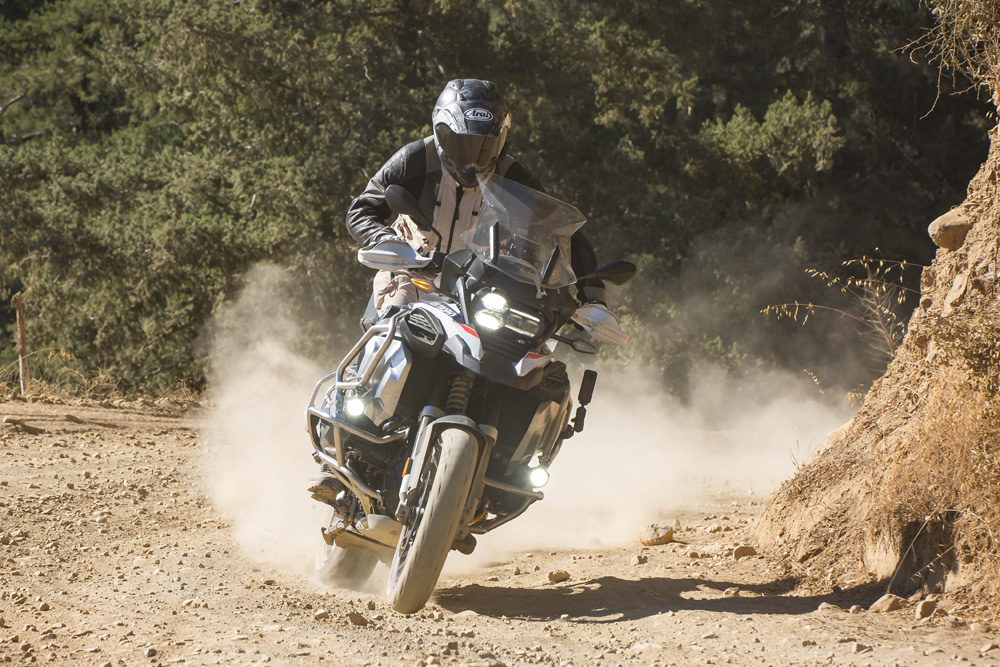 Letting the big dog eat. You can hustle a GS along in the dirt with surprising speed given its size.
Letting the big dog eat. You can hustle a GS along in the dirt with surprising speed given its size.
A Trip Down Memory Lane
With the R 1250 GS about to be put out to stud, we thought we’d take you for a trip down the GS model’s life to see where it’s come before we ride the new 1300 later this year.
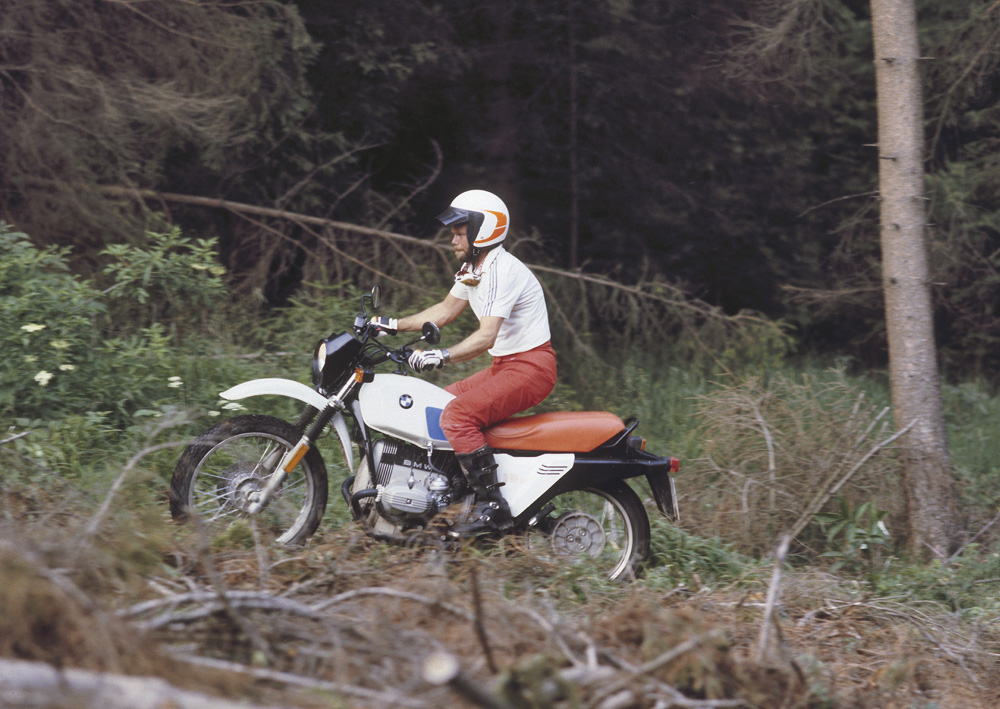
1980
Labelled the world’s first “adventure bike,” the R 80 G/S took off-road practicality and combined it with street-bike speed to create a whole new segment. It ran a 797cc flat-twin boxer motor with a claimed 50 horsepower and saw numerous successes in the Paris-Dakar Rally with riders Hubert Auriol and Gaston Raiher.
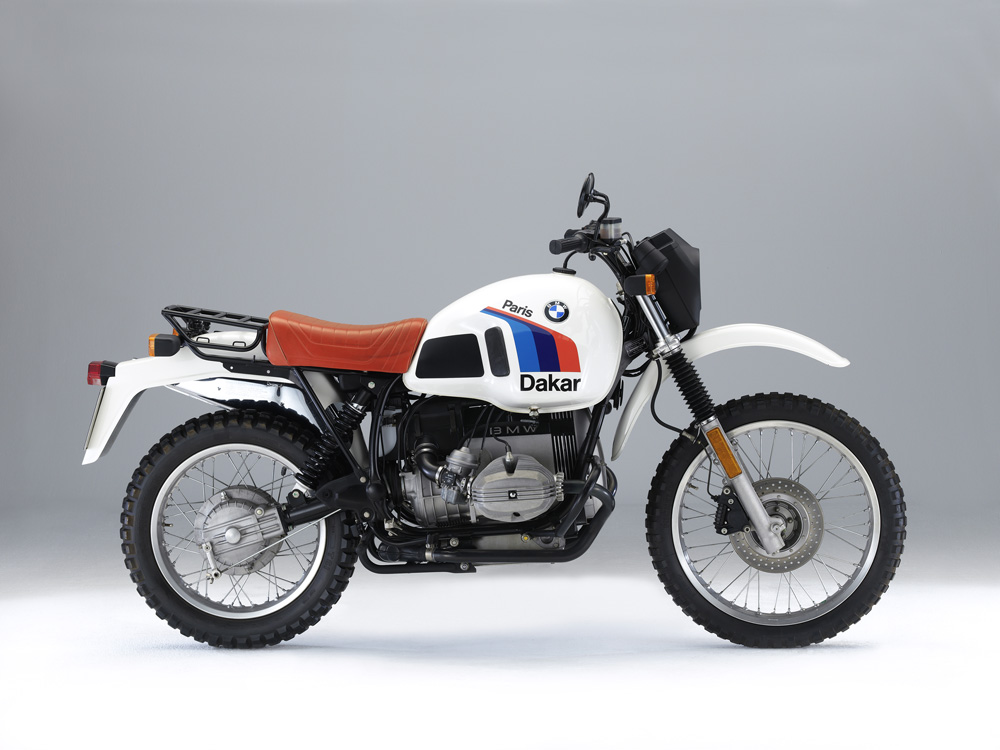
1984
BMW debuts the 1984 BMW R 80 G/S Paris-Dakar edition with a solo brown seat, protective bars, 8.5-gallon tank, and Paris-Dakar livery.
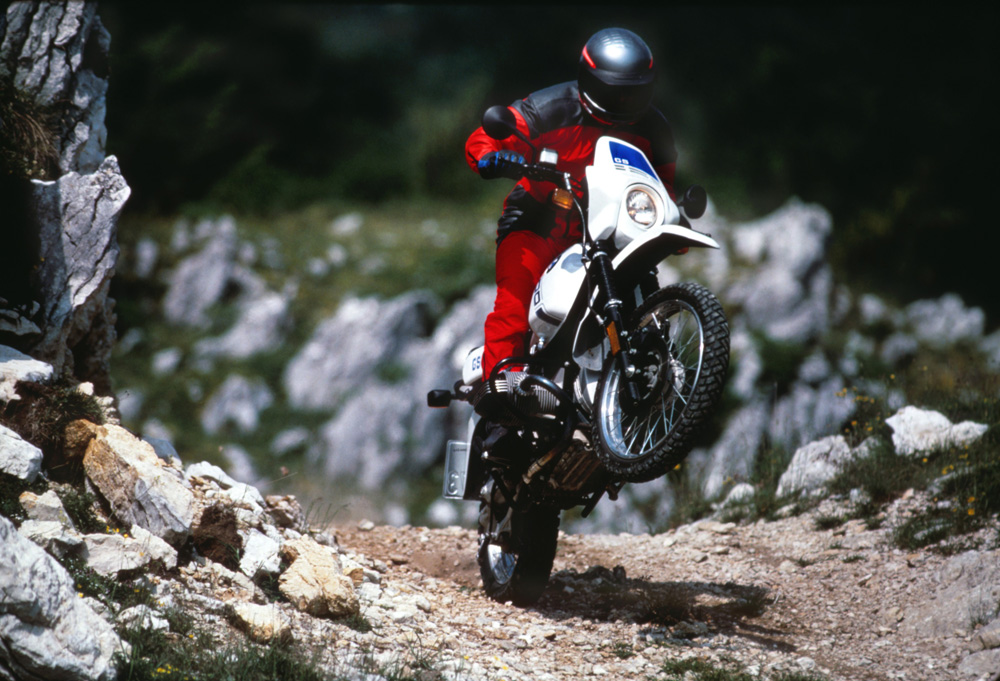
1988
Ran from 1988-1996, capacity is bumped to 980cc to produce 60 horsepower. Full redesign included bigger 40mm Marzocchi forks (replacing BMW 36mm units), and 17-inch rear wheel hinted more at the bike’s on-road capabilities.
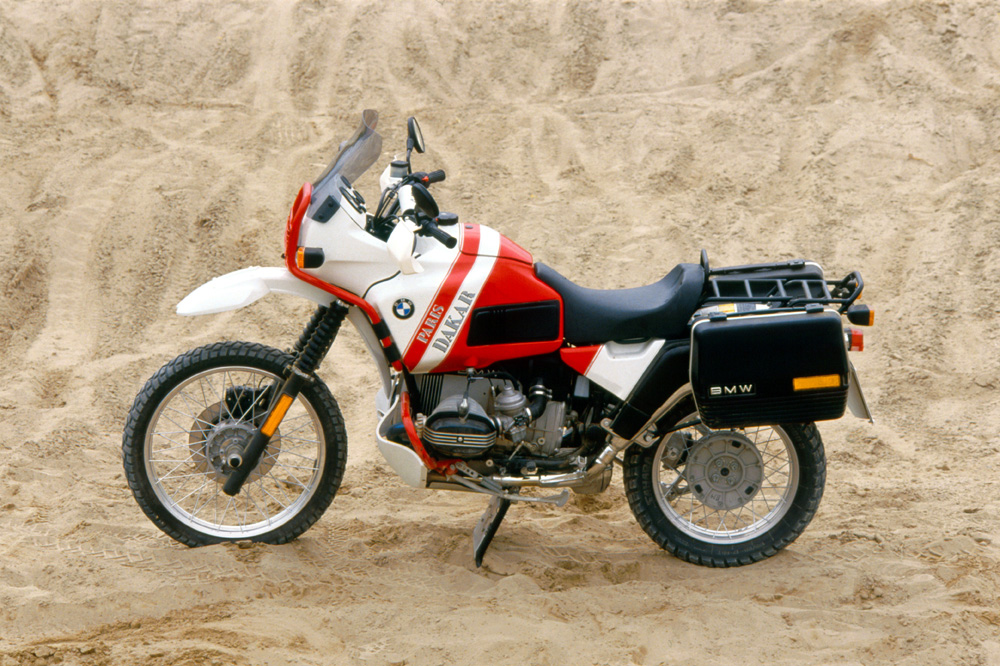
1990
A new Paris-Dakar GS is unveiled. Race-inspired paint, crash protection and a larger 8.1-gallon gas tank are the main features.
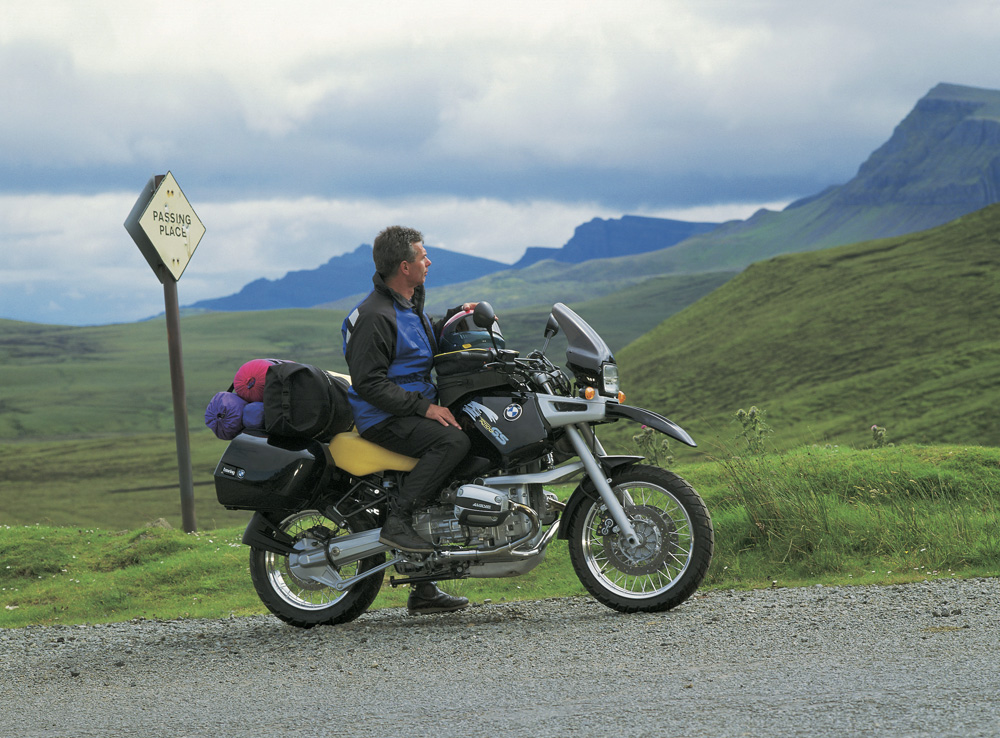
1994
The year the GS takes its formative shape in the R 1100 GS. Completely redesigned in 1085cc spec with all-new chassis and electronics, the race inspiration of the GS for mass production is ditched for the world traveler look we know today. The smaller R 80 GS (848cc) makes its debut two years later.
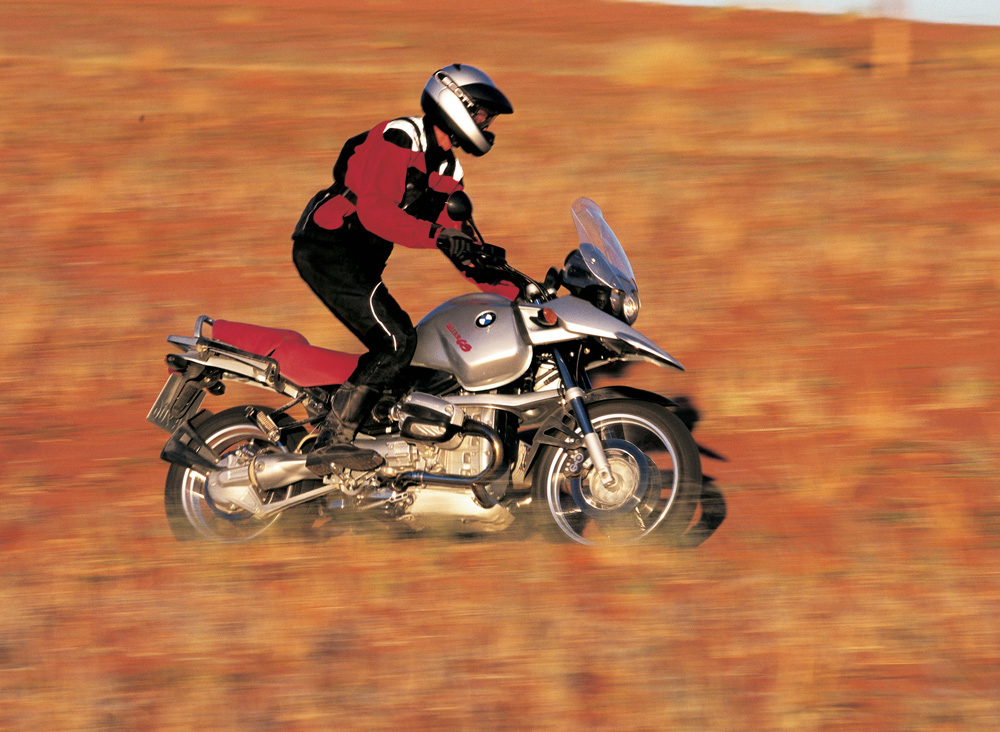
1999
Now bumped to R 1150 GS (1130cc) stature with a claimed 85 horsepower and twin-spark heads. Model runs from 1999 to 2004, gains a six-speed gearbox, and in 2002, the optional ABS braking system was replaced with an electrically servo-assisted combined braking system that’s still in place today. Also, in 2002, the R 1150 GS Adventure made its debut.
The smaller F 650 GS made its production debut in 2000.
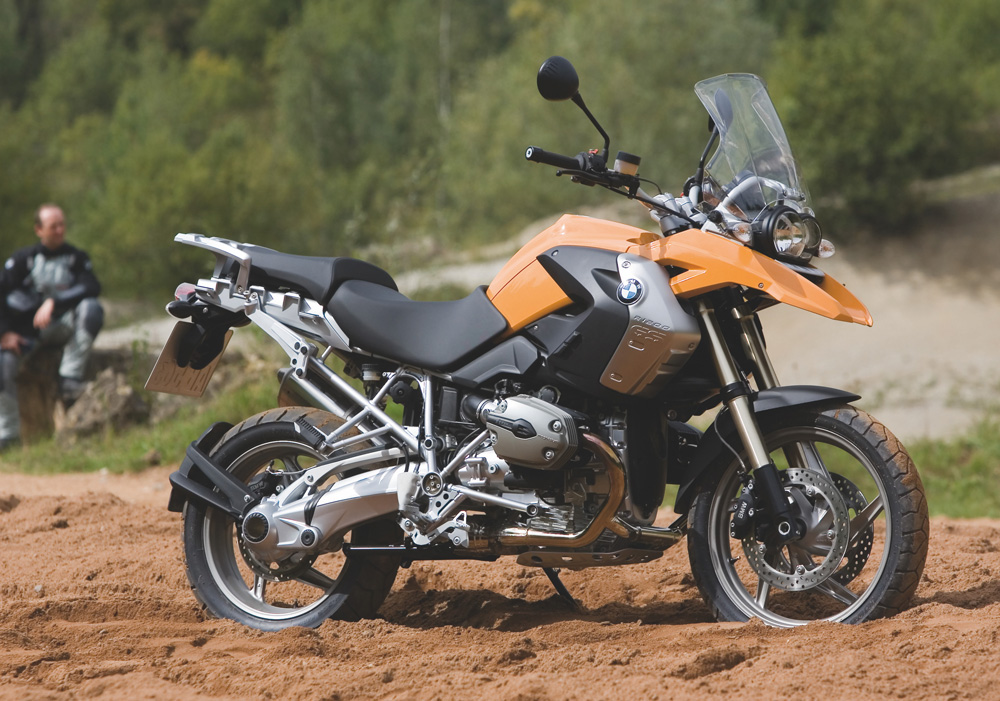
2004
The R 1200 GS makes its arrival. Engine capacity is bumped from 1130cc to 1170cc. Vastly improved over the 1150, the 1200 combined 98 horsepower and 85 lb-ft of torque with a revised chassis, new bodywork and new electronics to create a bike that still holds its own today.
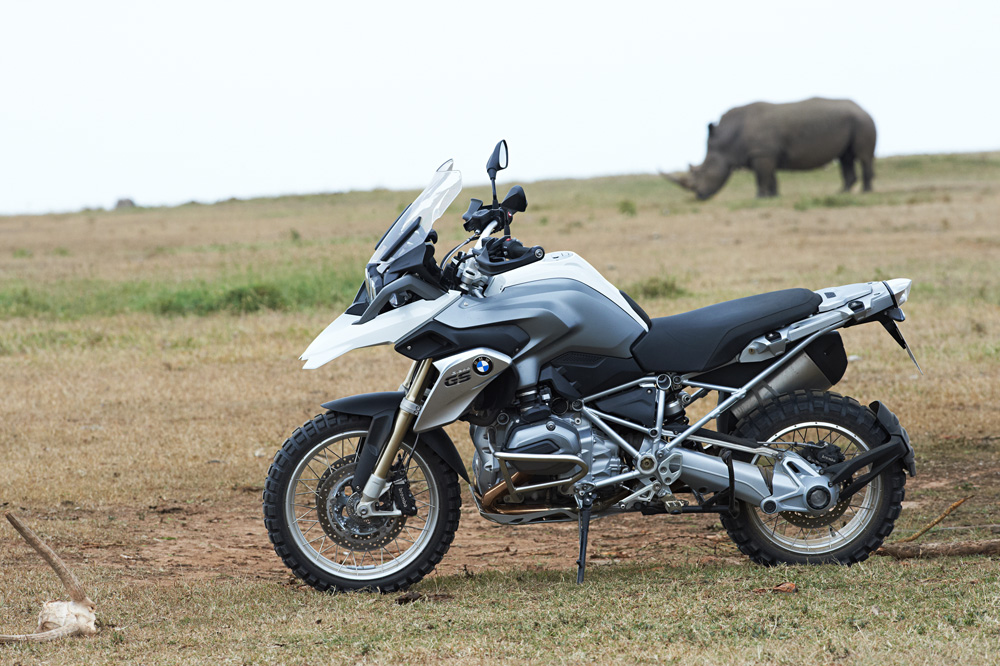
2013
The GS gets its largest overhaul yet. Now with partial water-cooling, the GS motor pumps out a claimed 125 horsepower and the chassis and suspension are fully revised. BMW updates the electronics, including optional satnav, LED headlights, new Dynamic ESA, ride-by-wire throttle, enhanced riding modes, updated traction control, and the lot.
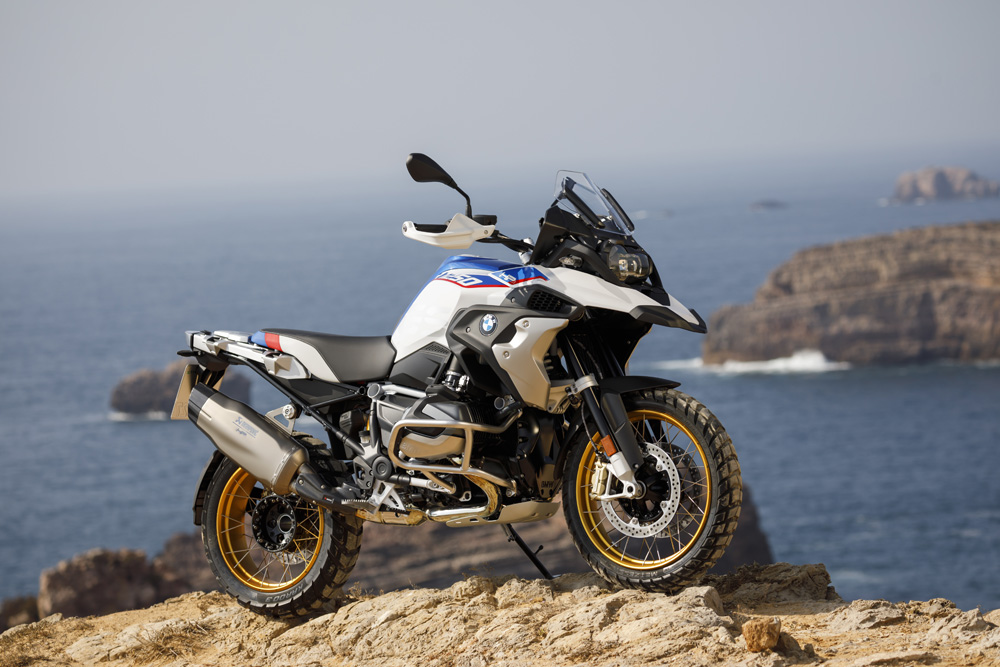
2018
BMW’s latest iteration, the R 1250 GS, turns up. The 1254cc flat-twin motor now adds variable valve timing to the mix via its ShiftCam system, where the intake camshafts have two cam lobes per valve that can be switched within one cam revolution between partial-throttle and open-throttle cam profiles. BMW claims 130 horsepower and 105 lb-ft for the best, although weight is up a few pounds over the predecessor. CN
2023 BMW R 1250 GS Trophy Adventure Specifications
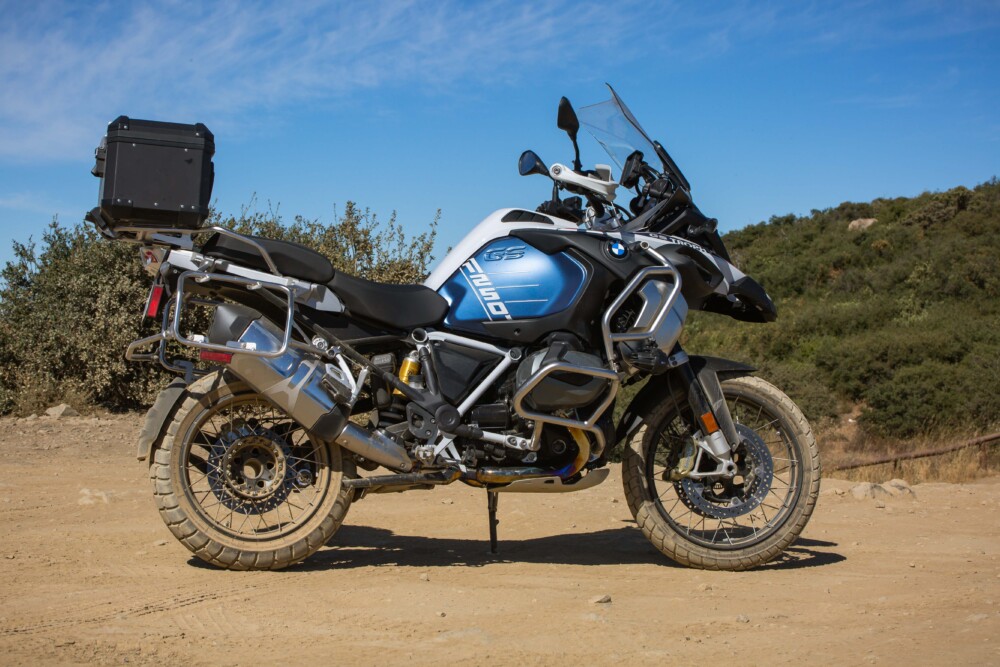
| MSRP: |
$24,685 |
| Engine: |
4-stroke flat twin |
| Valvetrain: |
Double overhead camshaft, one balance shaft and variable engine timing system BMW ShiftCam |
| Cooling system: |
Air/liquid |
| Displacement: |
1254cc |
| Bore x stroke: |
102 x 76 mm |
| Compression ratio: |
12.5:1 |
| Horsepower (claimed): |
136 hp at 7750 rpm |
| Torque (claimed): |
105 lb-ft at 6250 rpm |
| Fuel system: |
Electronic intake pipe injection |
| Exhaust system: |
2-2-1 |
| Transmission: |
6-speed |
| Clutch: |
Wet, assist & slip |
| Final drive: |
Shaft |
| Electronics (as tested): |
DTC Dynamic Traction Control, Heated Grips, TPM Tire Pressure Monitor, ABS Pro, Dynamic ESA, Keyless Ride, GPS Preparation, Cruise Control, LED Auxiliary Lights, Gear Shift Assist Pro, Ride Modes Pro |
| Frame: |
Two-section frame, front- and bolted-on rear frame, load-bearing engine |
| Front suspension: |
BMW Motorrad Telelever; stanchion diameter 1.5 in. (37mm), central spring strut |
| Rear suspension: |
Cast aluminum single-sided swingarm with BMW Motorrad Paralever, spring pre-load, rebound damping adjustable |
| Front-wheel Travel: |
8.3 in. |
| Rear-wheel Travel: |
8.7 in. |
| Front tire: |
120/70 R 19 in. |
| Rear tire: |
170/60 R 17 in. |
| Front brake: |
Dual 305mm disc brake, floating brake discs, 4-piston radial calipers, ABS Pro |
| Rear brake: |
Single 276mm disc brake, double-piston floating caliper, ABS Pro |
| Seat height: |
35.0 in. / 35.8 in. |
| Rake: |
26.3° |
| Trail: |
4.1 in. |
| Wheelbase: |
59.7 in. |
| Fuel capacity: |
7.9 gal. |
| Weight (claimed): |
591 lbs. |
